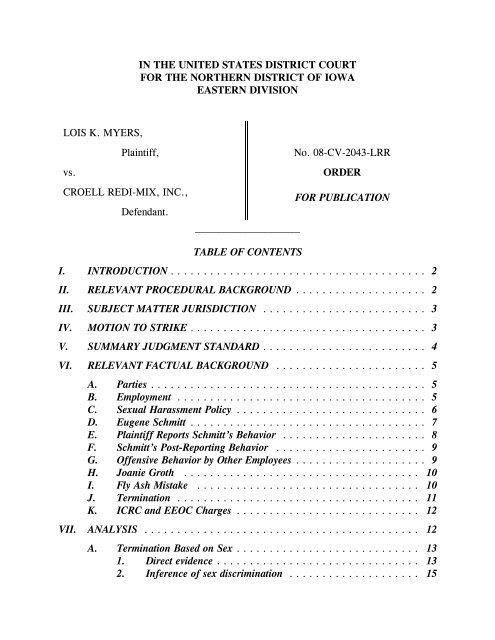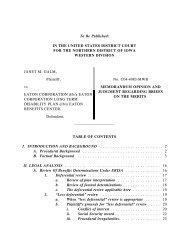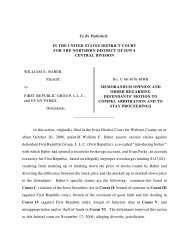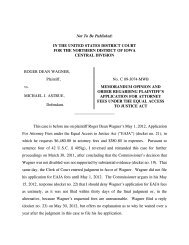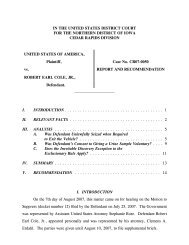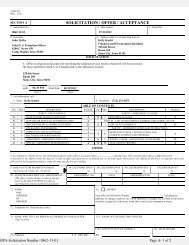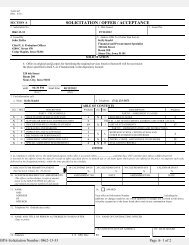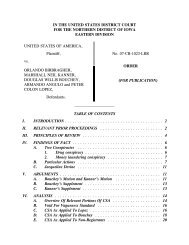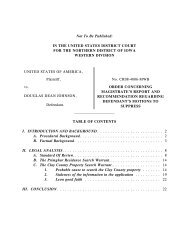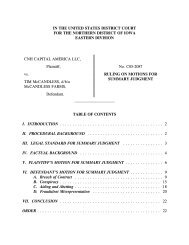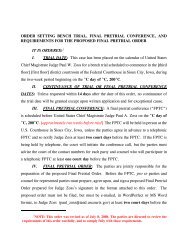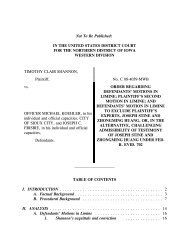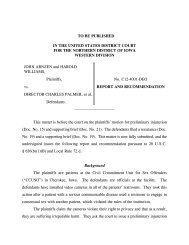Lois K. Myers v. Croell Redi-Mix, Inc. - Northern District of Iowa
Lois K. Myers v. Croell Redi-Mix, Inc. - Northern District of Iowa
Lois K. Myers v. Croell Redi-Mix, Inc. - Northern District of Iowa
Create successful ePaper yourself
Turn your PDF publications into a flip-book with our unique Google optimized e-Paper software.
IN THE UNITED STATES DISTRICT COURT<br />
FOR THE NORTHERN DISTRICT OF IOWA<br />
EASTERN DIVISION<br />
LOIS K. MYERS,<br />
Plaintiff,<br />
No. 08-CV-2043-LRR<br />
vs.<br />
CROELL REDI-MIX, INC.,<br />
Defendant.<br />
____________________<br />
ORDER<br />
FOR PUBLICATION<br />
TABLE OF CONTENTS<br />
I. INTRODUCTION ....................................... 2<br />
II. RELEVANT PROCEDURAL BACKGROUND .................... 2<br />
III. SUBJECT MATTER JURISDICTION ......................... 3<br />
IV. MOTION TO STRIKE .................................... 3<br />
V. SUMMARY JUDGMENT STANDARD ......................... 4<br />
VI. RELEVANT FACTUAL BACKGROUND ....................... 5<br />
A. Parties .......................................... 5<br />
B. Employment ...................................... 5<br />
C. Sexual Harassment Policy ............................. 6<br />
D. Eugene Schmitt .................................... 7<br />
E. Plaintiff Reports Schmitt’s Behavior ...................... 8<br />
F. Schmitt’s Post-Reporting Behavior ....................... 9<br />
G. Offensive Behavior by Other Employees .................... 9<br />
H. Joanie Groth .................................... 10<br />
I. Fly Ash Mistake .................................. 10<br />
J. Termination ..................................... 11<br />
K. ICRC and EEOC Charges ............................ 12<br />
VII. ANALYSIS .......................................... 12<br />
A. Termination Based on Sex ............................ 13<br />
1. Direct evidence ............................... 13<br />
2. Inference <strong>of</strong> sex discrimination .................... 15
a. McDonnell Douglas Framework ............... 15<br />
b. Analysis ............................... 15<br />
B. Retaliation Claim .................................. 20<br />
C. Disparate Treatment ................................ 22<br />
D. Hostile Work Environment ........................... 25<br />
1. Severe or pervasive harassment .................... 26<br />
a. Harassment prior to July 28, 2003 .............. 27<br />
b. Harassment after July 28, 2003 ............... 28<br />
2. Defendant’s knowledge <strong>of</strong> harassment ............... 30<br />
a. Actual knowledge ......................... 31<br />
b. Constructive knowledge ..................... 33<br />
c. Summary .............................. 34<br />
3. Ellerth-Faragher defense ........................ 35<br />
VIII. CONCLUSION ....................................... 36<br />
I. INTRODUCTION<br />
The matters before the court are Defendant <strong>Croell</strong> <strong>Redi</strong>-<strong>Mix</strong>, <strong>Inc</strong>.’s “Motion for<br />
Summary Judgment” (“Motion”) (docket no. 15) and “Motion to Strike Certain Affidavits<br />
Submitted by Plaintiff” (“Motion to Strike”) (docket no. 23).<br />
II. RELEVANT PROCEDURAL BACKGROUND<br />
On June 6, 2008, Plaintiff <strong>Lois</strong> K. <strong>Myers</strong> filed a Complaint (docket no. 2) against<br />
Defendant. In the Complaint, Plaintiff alleges that Defendant violated her rights under<br />
Title VII <strong>of</strong> the Civil Rights Act <strong>of</strong> 1964, 42 U.S.C. § 2000e, et seq. (“Title VII”).<br />
Specifically, Plaintiff alleges that Defendant discriminated against Plaintiff because <strong>of</strong> her<br />
sex. On August 21, 2008, Defendant filed an Answer (docket no. 5) in which it denied<br />
the substance <strong>of</strong> Plaintiff’s claims.<br />
On August 27, 2009, Defendant filed the Motion. On September 17, 2009, Plaintiff<br />
filed a Resistance (docket no. 20). On September 28, 2009, Defendant filed a Reply<br />
(docket no. 22).<br />
That same date, Defendant filed the Motion to Strike. On October 9, 2009, Plaintiff<br />
filed a Resistance (docket no. 28) to the Motion to Strike. That same date, Defendant filed<br />
2
a Reply (docket no. 29).<br />
III. SUBJECT MATTER JURISDICTION<br />
The court has federal question jurisdiction over Plaintiff’s Title VII claims. See 28<br />
U.S.C. § 1331 (“The district courts shall have original jurisdiction <strong>of</strong> all civil actions<br />
arising under the Constitution, laws, or treaties <strong>of</strong> the United States”).<br />
IV. MOTION TO STRIKE<br />
In the Motion to Strike, Defendant asks the court to strike two affidavits that<br />
Plaintiff submitted in support <strong>of</strong> her Resistance. The affidavits are from two former<br />
employees <strong>of</strong> Defendant, Misty Troester and Jon Leiran. Defendant argues that the<br />
affidavits should be stricken because Plaintiff failed to: (1) disclose these individuals as<br />
witnesses in the initial disclosures required by Federal Rule <strong>of</strong> Civil Procedure 26(a) 1 and<br />
(2) identify Troester or Leiran in response to Defendant’s interrogatory asking Plaintiff to<br />
“identify each person who has or claims to have any knowledge <strong>of</strong> the facts and<br />
circumstances relating to the allegations <strong>of</strong> the [C]omplaint.” Def. Brief (docket no. 23-2)<br />
at 1.<br />
Plaintiff concedes that she failed to disclose Troester and Leiran in her Rule 26(a)<br />
disclosures and discovery. However, Plaintiff argues that Defendant will not be prejudiced<br />
by the court’s consideration <strong>of</strong> the affidavits. Plaintiff argues that, if the court denies the<br />
Motion, Defendant will have sufficient time to depose Troester and Leiran prior to trial.<br />
Trial in the instant action is currently scheduled for the two-week period commencing on<br />
January 19, 2010.<br />
For purposes <strong>of</strong> the Motion, the court shall consider the Leiran and Troester<br />
affidavits. However, the court finds that, even when it considers the affidavits, Plaintiff<br />
1 Federal Rule <strong>of</strong> Civil Procedure 26(a) requires a party to disclose, without<br />
awaiting a discovery request, “the name and, if known, the address and telephone number<br />
<strong>of</strong> each individual likely to have discoverable information . . . that the disclosing party<br />
may use to support its claims or defenses . . . .” Fed. R. Civ. P. 26(a)(1).<br />
3
fails to put forth sufficient evidence to create a genuine issue <strong>of</strong> material fact with regard<br />
to her Title VII claims. Accordingly, the court shall deny the Motion to Strike. In light<br />
<strong>of</strong> the fact that the court shall grant the Motion, the court finds that Defendant is not<br />
prejudiced by the court’s consideration <strong>of</strong> the affidavits.<br />
V. SUMMARY JUDGMENT STANDARD<br />
Summary judgment is appropriate “if the pleadings, the discovery and disclosure<br />
materials on file, and any affidavits show that there is no genuine issue as to any material<br />
fact and that the movant is entitled to judgment as a matter <strong>of</strong> law.” Fed. R. Civ. P. 56(c).<br />
“An issue <strong>of</strong> fact is genuine when ‘a reasonable jury could return a verdict for the<br />
nonmoving party’ on the question.” Woods v. DaimlerChrysler Corp., 409 F.3d 984, 990<br />
(8th Cir. 2005) (quoting Anderson v. Liberty Lobby, <strong>Inc</strong>., 477 U.S. 242, 248 (1986)). A<br />
fact is material when it “might affect the outcome <strong>of</strong> the suit under the governing law.”<br />
Anderson, 477 U.S. at 248. “[T]o establish the existence <strong>of</strong> a genuine issue <strong>of</strong> material<br />
fact, ‘a plaintiff may not merely point to unsupported self-serving allegations.’” Anda v.<br />
Wickes Furniture Co., 517 F.3d 526, 531 (8th Cir. 2008) (quoting Bass v. SBC Commc’ns,<br />
<strong>Inc</strong>., 418 F.3d 870, 872 (8th Cir. 2005)). Rather, the nonmoving party “‘must<br />
substantiate [its] allegations with sufficient probative evidence that would permit a finding<br />
in [its] favor.’” Anda, 517 F.3d at 531 (quoting Bass, 418 F.3d at 873). The court must<br />
view the record in the light most favorable to the nonmoving party and afford it all<br />
reasonable inferences. Baer Gallery, <strong>Inc</strong>. v. Citizen’s Scholarship Found. <strong>of</strong> Am., <strong>Inc</strong>.,<br />
450 F.3d 816, 820 (8th Cir. 2006) (citing Drake ex rel. Cotton v. Koss, 445 F.3d 1038,<br />
1042 (8th Cir. 2006)).<br />
Procedurally, the moving party bears “the initial responsibility <strong>of</strong> informing the<br />
district court <strong>of</strong> the basis for its motion and identifying those portions <strong>of</strong> the record which<br />
show a lack <strong>of</strong> a genuine issue.” Hartnagel v. Norman, 953 F.2d 394, 395 (8th Cir. 1992)<br />
(citing Celotex Corp. v. Catrett, 477 U.S. 317, 323 (1986)). Once the moving party has<br />
4
successfully carried its burden under Rule 56(c), the nonmoving party has an affirmative<br />
burden to go beyond the pleadings and by depositions, affidavits, or otherwise, “set out<br />
specific facts showing a genuine issue for trial.” Fed. R. Civ. P. 56(e)(2); see, e.g., Baum<br />
v. Helget Gas Prods., <strong>Inc</strong>., 440 F.3d 1019, 1022 (8th Cir. 2006) (“Summary judgment is<br />
not appropriate if the non-moving party can set forth specific facts, by affidavit,<br />
deposition, or other evidence, showing a genuine issue for trial.”). The nonmoving party<br />
must <strong>of</strong>fer pro<strong>of</strong> “such that a reasonable jury could return a verdict for the nonmoving<br />
party.” Anderson, 477 U.S. at 248. “‘Evidence, not contentions, avoids summary<br />
judgment.’” Reasonover v. St. Louis County, Mo., 447 F.3d 569, 578 (8th Cir. 2006)<br />
(quoting Mayer v. Nextel W. Corp., 318 F.3d 803, 809 (8th Cir. 2003)).<br />
VI. RELEVANT FACTUAL BACKGROUND<br />
Viewing the facts in the light most favorable to Plaintiff and affording her all<br />
reasonable inferences, the undisputed facts are as follows:<br />
A. Parties<br />
Plaintiff is a 54-year-old-female. She resides in Lawler, <strong>Iowa</strong>. Defendant is an<br />
<strong>Iowa</strong> corporation with its principal place <strong>of</strong> business in New Hampton, <strong>Iowa</strong>. Defendant<br />
produces ready-mix concrete and operates concrete plants throughout <strong>Iowa</strong> and elsewhere.<br />
B. Employment<br />
On July 25, 1995, Defendant hired Plaintiff for a powder hauler position. As a<br />
powder hauler, Plaintiff drove a semi-tractor and trailer (“truck”) and was also responsible<br />
for the general maintenance <strong>of</strong> her truck. Plaintiff picked up cement powder in Mason<br />
City, <strong>Iowa</strong> and “fly ash” 2 in Lansing, <strong>Iowa</strong>. Plaintiff delivered these products to<br />
Defendant’s production facilities.<br />
2 “Fly ash” is a cement replacement that is sometimes mixed in varying amounts<br />
in concrete mixtures. Excessive fly ash in a concrete mixture can hinder the setting<br />
process.<br />
5
C. Sexual Harassment Policy<br />
Defendant’s employee handbook contained a sexual harassment policy. Plaintiff<br />
read the employee handbook, including the sexual harassment policy, when she was hired<br />
in 1995. Defendant’s sexual harassment policy provides, in relevant part:<br />
It is the policy <strong>of</strong> [Defendant] that all employees are to enjoy<br />
a work environment free from all forms <strong>of</strong> discrimination,<br />
including sexual harassment. Sexual harassment, whether by<br />
supervisory or non-supervisory personnel, is prohibited. Any<br />
employee who engages in sexual harassment will receive<br />
appropriate discipline, up to and including termination. Sexual<br />
harassment includes <strong>of</strong>fensive flirtation, unwelcome sexual<br />
advances or propositions, verbal abuse <strong>of</strong> a sexual nature,<br />
sexually graphic or degrading comments about an individual or<br />
his/her appearance, the display <strong>of</strong> sexually suggestive objects<br />
or pictures, and any <strong>of</strong>fensive or abusive physical contact <strong>of</strong> a<br />
sexual nature.<br />
Defendant’s Appendix (“Def. App’x”) (docket nos. 15-3 & 15-4), at 109.<br />
provides:<br />
Defendant’s policy also contained a sexual harassment complaint procedure, which<br />
If you encounter conduct which you believe violates this policy<br />
against sexual harassment, you may submit a complaint orally<br />
or in writing to your supervisor, or to any <strong>of</strong> the owners <strong>of</strong> the<br />
Company listed in the front <strong>of</strong> this handbook directly. You<br />
must not assume that the Company knows <strong>of</strong> the conduct<br />
unless such a complaint is made. There will be no retaliation<br />
against any employee for filing a complaint or against any<br />
person for participating in the complaint procedure. Each<br />
complaint will be investigated, and confidentiality will be<br />
maintained to the extent it is consistent with an effective<br />
investigation. If sexual harassment is found, action will be<br />
taken to end the harassment and prevent further recurrence <strong>of</strong><br />
the misconduct.<br />
Id. Plaintiff understood that Defendant’s policy directed her to make sexual harassment<br />
complaints orally or in writing to her supervisor or to any listed owner <strong>of</strong> the company.<br />
6
Plaintiff understood that Defendant considered sexual harassment “non-tolerable.” Id. at<br />
30-31.<br />
D. Eugene Schmitt<br />
Shortly after Plaintiff began work, an employee named Eugene Schmitt began to<br />
harass Plaintiff. Schmitt managed Defendant’s Lawler, <strong>Iowa</strong> plant until 2002. Schmitt<br />
was also the “tire manager” for the entire company. Plaintiff’s Brief (“Pl. Brief”) (docket<br />
no. 20-1), at 1. As the tire manager, Schmitt was responsible for ensuring Defendant’s<br />
trucks received new tires when needed.<br />
Schmitt urinated in Plaintiff’s presence, spit chewing tobacco where Plaintiff walked<br />
and slapped Plaintiff’s buttocks “at least four times.” 3 Id. at 19. On one occasion,<br />
Plaintiff was bent down working on a tire. Schmitt approached Plaintiff in a manner that<br />
caused the zipper area <strong>of</strong> his pants to be at approximately the same level as Plaintiff’s face<br />
and about one and a half feet away. Schmitt told Plaintiff that she was “just the right<br />
height.” Pl. App’x at 154. Plaintiff did not report this conduct to management or the<br />
owners <strong>of</strong> the company.<br />
In 2002, Keith Panos replaced Schmitt as the manager <strong>of</strong> the Lawler plant. It is<br />
unclear whether Schmitt continued to work at the Lawler plant after 2002. However,<br />
Schmitt retained his position as tire manager.<br />
In July <strong>of</strong> 2003, Plaintiff had a heated confrontation with Schmitt at the Lawler<br />
plant. Schmitt “scream[ed]” at Plaintiff that she should be able to change her tires like<br />
some <strong>of</strong> the male drivers. Pl. Brief at 3. Plaintiff told Schmitt to “go sit back down and<br />
resume counting cars.” Pl. App’x at 150. Plaintiff and Schmitt then exchanged<br />
pr<strong>of</strong>anities, both telling the other, “fuck you.” Def. App’x at 23.<br />
3 These incidents apparently occurred prior to July <strong>of</strong> 2003. However, Plaintiff<br />
does not otherwise indicate when or how <strong>of</strong>ten these incidents occurred.<br />
7
E. Plaintiff Reports Schmitt’s Behavior<br />
On July 28, 2003, Plaintiff complained <strong>of</strong> Schmitt’s behavior. Specifically, Plaintiff<br />
complained to Defendant’s Safety Director, Joanie Groth, and the Vice President <strong>of</strong><br />
Defendant’s <strong>Iowa</strong> Division, Harlan Taylor. Plaintiff did not report Schmitt’s behavior to<br />
her supervisor or to any owner. Taylor told Plaintiff that he would “take care <strong>of</strong> it.” Id.<br />
at 22. Plaintiff did not hear back from Taylor and was not told whether Schmitt was<br />
disciplined. However, both Taylor and Groth testified that they spoke to Schmitt and told<br />
him that the harassment must stop. Taylor told Schmitt that the harassment was “not<br />
tolerated.” Id. at 94.<br />
After Plaintiff’s complaint, Schmitt’s verbal harassment stopped and Schmitt did not<br />
speak to Plaintiff. Plaintiff acknowledges that “[t]he extreme overt sexual harassment<br />
stopped” after her complaint. Pl. App’x at 150. Groth later spoke to Plaintiff and “asked<br />
how [Schmitt] was being” and whether Schmitt “was leaving [Plaintiff] alone or<br />
whatever.” 4 Def. App’x at 30. Plaintiff and Brenda Winzenberg, one <strong>of</strong> Defendant’s<br />
dispatchers, also took steps to separate Plaintiff and Schmitt. Plaintiff began to unload her<br />
4 Plaintiff testified at her deposition that Groth made these statements to her. In her<br />
“Response to Defendant’s Statement <strong>of</strong> Undisputed Material Facts” (docket no. 20-2),<br />
however, Plaintiff states that this fact is “admitted with explanation” and states that she<br />
“has no recollection <strong>of</strong> Groth contacting her regarding [Schmitt’s] conduct.” Response at<br />
18. In support <strong>of</strong> this statement, Plaintiff cites her own affidavit, in which she states that<br />
she was “never informed as to whether [Schmitt] was disciplined, or if he was, what the<br />
discipline was.” Pl. App’x at 154. The court does not construe this as a denial or direct<br />
contradiction <strong>of</strong> Plaintiff’s deposition testimony. To the extent it could be construed as a<br />
denial or a direct contradiction, the court notes that Plaintiff cannot create sham issues <strong>of</strong><br />
material fact by contradicting her own previous testimony. See City <strong>of</strong> St. Joseph v.<br />
Southwestern Bell Tel., 439 F.3d 468, 475-76 (8th Cir. 2006) (citing Camfield Tires, <strong>Inc</strong>.<br />
v. Michelin Tire Corp., 719 F.2d 1361, 1365 (8th Cir. 1983)) (“[A]n affidavit filed by the<br />
plaintiff in opposition to a motion for summary judgment that directly contradicted the<br />
plaintiff’s previous deposition testimony was insufficient to create a genuine issue <strong>of</strong><br />
material fact under Rule 56.”)<br />
8
truck prior to Schmitt’s arrival in the morning, and other similar arrangements were made<br />
to minimize her contact with Schmitt.<br />
F. Schmitt’s Post-Reporting Behavior<br />
Between Plaintiff’s 2003 complaint and her termination on December 1, 2006,<br />
Schmitt committed several acts that Plaintiff considered harassing. On one occasion,<br />
Plaintiff was refueling her truck when Schmitt drove by and continuously honked his horn<br />
and then sniffed his finger and licked his mustache. Plaintiff believed Schmitt’s conduct<br />
indicated oral or digital sex. On another occasion, Schmitt drove by Plaintiff’s home and<br />
sniffed his finger. On another occasion, Plaintiff was following Schmitt into the Lawler<br />
plant and Schmitt slammed the door in Plaintiff’s face. Plaintiff never reported these<br />
incidents.<br />
Schmitt also allegedly made statements to other employees that Plaintiff found<br />
<strong>of</strong>fensive. In 2005 or 2006, an employee, Shawn Moody, told Plaintiff that Schmitt was<br />
spreading a rumor that Plaintiff had an intimate relationship with Panos. On another<br />
occasion, Schmitt allegedly told Panos that Plaintiff made a mistake and a supervisor was<br />
going to write her up. However, Plaintiff was never disciplined for any alleged mistake.<br />
Plaintiff never reported these incidents.<br />
G. Offensive Behavior by Other Employees<br />
After Plaintiff’s 2003 complaint, other employees also treated Plaintiff in a manner<br />
that she found <strong>of</strong>fensive. Two co-workers, Toni Seevers and Keith Glaser, asked Plaintiff<br />
if her “boob” or “tit” was ringing because Plaintiff kept her cell phone in the strap <strong>of</strong> her<br />
brassiere and used a vibrating ring. Def. App’x at 49. Seevers also asked Plaintiff if she<br />
was “pissing in [Harlan Taylor’s] Cheerios” because Plaintiff was unhappy with the<br />
amount <strong>of</strong> work she was getting. Id. During a Christmas party in 2004, a co-worker,<br />
Craig Miller, unzipped Plaintiff’s shirt in front <strong>of</strong> co-workers. Another co-worker, Bob<br />
Dreckman, called Plaintiff a “dizzy bitch” on multiple occasions. Id. 52. Glaser also<br />
9
allegedly asked Panos if he and Plaintiff were leaving “dick tracks” on a desk. Id. at 49.<br />
Plaintiff never reported any <strong>of</strong> these incidents to her supervisor or the listed owners <strong>of</strong> the<br />
company.<br />
H. Joanie Groth<br />
Sometime in 2005, Plaintiff observed Joanie Groth kiss or be kissed by Schmitt.<br />
Plaintiff and other employees also observed Groth wear clothing that they considered<br />
inappropriate for work at a concrete company. Other employees allegedly witnessed Groth<br />
engage in sexually inappropriate behavior, such as “mooning” other employees. 5 In 2001,<br />
prior to Groth becoming Safety Director, Jon Leiran went to Defendant’s Waukon, <strong>Iowa</strong><br />
plant “after hours” and observed Groth and a male employee after they had possibly<br />
engaged in a sex act. 6 Pl. App’x at 172. Schmitt also told Plaintiff that he was a “good<br />
friend” <strong>of</strong> Defendant’s CEO, Roger <strong>Croell</strong>, and Groth. This caused Plaintiff to believe<br />
that Schmitt was somehow protected from discipline.<br />
I. Fly Ash Mistake<br />
On November 28, 2006, Plaintiff delivered a load <strong>of</strong> fly ash to Defendant’s New<br />
Hampton plant. Plaintiff could not find the plant manager or any other personnel when she<br />
arrived. Plaintiff mistakenly hooked her unloading pipe to the cement silo pipe.<br />
Consequently, Plaintiff blew fly ash into the cement silo for approximately four minutes.<br />
Plaintiff knew that it could cost Defendant money if the concrete in the silo was used<br />
without knowledge <strong>of</strong> the fly ash content. Plaintiff also knew that Defendant’s policy<br />
required her to report such mistakes to her supervisor and assist with the completion <strong>of</strong> an<br />
5 Most <strong>of</strong> the factual allegations regarding Groth’s alleged conduct are contained<br />
in the two affidavits that are the subject <strong>of</strong> Defendant’s Motion to Strike. As previously<br />
noted, the court deems it appropriate to consider the facts raised in the affidavits for the<br />
purpose <strong>of</strong> ruling on the Motion.<br />
6 Plaintiff does not state if she was ever aware <strong>of</strong> Leiran’s observation, and if so,<br />
when she became aware <strong>of</strong> it.<br />
10
incident report.<br />
After realizing her mistake, Plaintiff was unable to find the New Hampton manager,<br />
Tom Holschlag, or any other employee. Plaintiff did not complete a report or leave any<br />
other message at the New Hampton plant. Plaintiff returned to the Lawler plant and<br />
reported the mistake to Panos. Panos unsuccessfully attempted to contact Holschlag on the<br />
company radio. Panos then telephoned what Plaintiff assumed was the New Hampton<br />
plant. Plaintiff left for a doctor’s appointment before Panos concluded this conversation.<br />
During this telephone coversation, Panos actually spoke with a mechanic at the New<br />
Hampton plant and asked that Holschlag return his call. Holschlag never returned Panos’<br />
call and therefore was not informed <strong>of</strong> Plaintiff’s mistake.<br />
On November 29, 2006, Defendant’s New Hampton plant delivered approximately<br />
24 yards <strong>of</strong> concrete to a contractor at Sparboe Foods in New Hampton. The concrete was<br />
poured at the job site. On November 30, 2006, Defendant was notified that the concrete<br />
was not setting properly. Harlan Taylor went to the site and discovered that the concrete<br />
remained s<strong>of</strong>t. Defendant ultimately had to remove the concrete and replace it. This<br />
incident cost Defendant approximately $6,600.<br />
Harlan Taylor investigated the defect and discovered fly ash in the cement pipe and<br />
silo at the New Hampton plant. Taylor learned that Plaintiff was the last person to deliver<br />
fly ash to the New Hampton plant. Taylor further discovered that nobody had informed<br />
Holschlag <strong>of</strong> Plaintiff’s mistake.<br />
J. Termination<br />
On December 1, 2006, Plaintiff’s daughter, Danielle <strong>Myers</strong>, was approached at her<br />
workplace by Paula Holschlag, Tom Holschlag’s wife. Paula Holschlag told Danielle<br />
<strong>Myers</strong> that Taylor discovered Plaintiff’s error and had noted that Plaintiff failed to report<br />
the mistake. Paula Holschlag told Danielle <strong>Myers</strong> that Plaintiff was going to be fired<br />
“because this had lost [Defendant] a million dollar job.” Pl. App’x at 168. Danielle<br />
11
<strong>Myers</strong> contacted Plaintiff and gave her this information.<br />
Later that same date, Taylor held a meeting with Plaintiff. Plaintiff admitted to<br />
Taylor that she had blown fly ash into the cement silo. Taylor asked Plaintiff if she had<br />
reported her mistake to anyone. Plaintiff responded that she had not reported it. Taylor<br />
then terminated Plaintiff’s employment based on her failure to report the incident. Plaintiff<br />
later testified that she did not tell Taylor she had reported the mistake to Panos because,<br />
based on Danielle <strong>Myers</strong>’s conversation with Paula Holschlag, Plaintiff already knew that<br />
she would be fired and she did not want Panos to get into trouble.<br />
K. ICRC and EEOC Charges<br />
In March <strong>of</strong> 2007, Plaintiff filed a charge <strong>of</strong> employment discrimination with the<br />
<strong>Iowa</strong> Civil Rights Commission (“ICRC”). The charge was cross-filed with the Equal<br />
Employment Opportunity Commission (“EEOC”). The ICRC conducted an investigation<br />
and issued a finding <strong>of</strong> no probable cause for Plaintiff’s allegations. The EEOC was<br />
unable to conclude whether a Title VII violation occurred. On March 10, 2008, the EEOC<br />
issued Plaintiff a right-to-sue letter.<br />
VII. ANALYSIS<br />
Title VII makes it unlawful for an employer “to discriminate against any individual<br />
with respect to [his or her] compensation, terms, conditions, or privileges <strong>of</strong> employment,<br />
because <strong>of</strong> such individual’s . . . sex . . . .” 42 U.S.C. § 2000e-2(a)(1). Plaintiff alleges<br />
that Defendant violated Title VII by: (1) terminating her employment because she is a<br />
woman; (2) terminating her employment in retaliation for her complaint <strong>of</strong> sexual<br />
harassment; (3) treating her differently with regard to work conditions because she is<br />
female; and (4) subjecting her to a hostile work environment.<br />
Defendant asks the court to grant the Motion and dismiss all <strong>of</strong> Plaintiff’s claims.<br />
Plaintiff resists the Motion in its entirety.<br />
12
A. Termination Based on Sex<br />
In a Title VII sex discrimination claim, a plaintiff may survive a defendant’s motion<br />
for summary judgment in one <strong>of</strong> two ways. McGinnis v. Union Pac. R.R., 496 F.3d 868,<br />
873 (8th Cir. 2007). First, the plaintiff may present “‘direct evidence <strong>of</strong> discrimination,<br />
that is, evidence showing a specific link between the alleged discriminatory animus and the<br />
challenged decision, sufficient to support a finding by a reasonable fact finder that an<br />
illegitimate criterion actually motivated the adverse employment action.’” Id. (quoting<br />
Russell v. City <strong>of</strong> Kan. City, Mo., 414 F.3d 863, 866 (8th Cir. 2005)). Second, “if the<br />
plaintiff lacks direct evidence <strong>of</strong> discrimination, the plaintiff may survive the defendant’s<br />
motion for summary judgment by creating an inference <strong>of</strong> unlawful discrimination under<br />
the burden-shifting framework established in McDonnell Douglas Corp. v. Green, 411<br />
U.S. 792 (1973).” McGinnis, 496 F.3d at 873. The court addresses each <strong>of</strong> these<br />
theories, in turn.<br />
1. Direct evidence<br />
Plaintiff argues that there is direct evidence that sex discrimination motivated<br />
Defendants’s decision to terminate her employment. First, Plaintiff contends that on her<br />
first day <strong>of</strong> work in 1995, Taylor, the Vice President <strong>of</strong> Defendant’s <strong>Iowa</strong> Division, “was<br />
hostile and unwelcoming, telling [Plaintiff] she did not know enough to be a powder<br />
hauler.” Pl. Brief at 10. Second, Plaintiff argues that Taylor expressed hostility during<br />
Plaintiff’s entire employment by repeatedly assigning her trucks with mechanical and/or<br />
safety issues and by failing to fix Plaintiff’s trucks. Plaintiff contends that this is direct<br />
evidence that sex discrimination motivated Defendant’s decision to terminate Plaintiff.<br />
“Direct evidence provides a strong causal link between the alleged discriminatory<br />
bias and the adverse employment decision.” McCullough v. Univ. <strong>of</strong> Ark. for Med.<br />
Sciences, 559 F.3d 855, 861 (8th Cir. 2009). Direct evidence “most <strong>of</strong>ten comprises<br />
remarks by decisionmakers that reflect, without inference, a discriminatory bias.” Id.<br />
13
“[S]tray remarks in the workplace, statements by nondecisionmakers, and statements by<br />
decisionmakers unrelated to the decisional process do not constitute direct evidence.” King<br />
v. United States, 553 F.3d 1156, 1160 (8th Cir. 2009) (citations and quotations omitted).<br />
Although Taylor was a decisionmaker in Plaintiff’s termination, his statement in<br />
1995 that Plaintiff “did not know enough to be a powder hauler” is “unrelated to the<br />
decisional process” to terminate Plaintiff’s employment in 2006. Id. The eleven-year gap<br />
between Taylor’s statement and Plaintiff’s termination also undermines Plaintiff’s claim<br />
that the statement constitutes direct evidence. See, e.g., Ramlet v. E.F. Johnson Co., 507<br />
F.3d 1149, 1153 (8th Cir. 2007) (holding that comments made more than four months<br />
prior to the adverse employment action were not related to the decision making process and<br />
therefore were not direct evidence). Further, an inference must be drawn to connect<br />
Taylor’s statement to any discriminatory motivation. Taylor’s statement did not indicate<br />
why he thought Plaintiff could not do the job and, standing alone, reflects no<br />
discriminatory bias based on sex. Accordingly, the court finds that this statement is not<br />
direct evidence <strong>of</strong> a discriminatory animus with regard to Plaintiff’s termination.<br />
The court also finds that Taylor’s alleged hostility toward Plaintiff during the course<br />
<strong>of</strong> her eleven-year employment does not constitute direct evidence <strong>of</strong> sex discrimination.<br />
Plaintiff contends that Taylor’s assignment <strong>of</strong> trucks with mechanical and/or safety<br />
problems is direct evidence that sex discrimination motivated her termination. The court<br />
disagrees. This evidence does not show a “specific link between the alleged discriminatory<br />
animus and the challenged decision.” McGinnis, 496 F.3d at 873. Rather, it is the type<br />
<strong>of</strong> evidence most typically used to create an inference <strong>of</strong> discrimination under the<br />
McDonnell-Douglas analysis. Plaintiff also fails to put forth evidence that Taylor assigned<br />
her defective trucks because she is a woman. Further, Plaintiff’s contention that Taylor<br />
assigned her defective trucks because he did not like her is not direct evidence that sex<br />
discrimination motivated his decision to terminate Plaintiff’s employment. In short,<br />
14
“[n]one <strong>of</strong> [Plaintiff’s] pro<strong>of</strong> establishes a direct link between [her] discharge and any bias<br />
against [her] because [she] is a [woman].” McCullough, 559 F.3d at 861. Accordingly,<br />
the court turns to consider whether Plaintiff has created an inference <strong>of</strong> sex discrimination<br />
under the McDonnell-Douglas burden-shifting framework.<br />
2. Inference <strong>of</strong> sex discrimination<br />
a. McDonnell Douglas framework<br />
Under the McDonnell Douglas framework, Plaintiff must first establish a prima<br />
facie case <strong>of</strong> sex discrimination. That is, Plaintiff must show that: (1) she is within the<br />
protected class; (2) she was qualified to perform her job; (3) she suffered an adverse<br />
employment action; and (4) circumstances permit an inference <strong>of</strong> sex discrimination.<br />
Holland v. Sam’s Club, 487 F.3d 641, 644 (8th Cir. 2007). If Plaintiff establishes a prima<br />
facie case <strong>of</strong> sex discrimination, a presumption <strong>of</strong> discrimination arises. Bearden v. Int’l<br />
Paper Co., 529 F.3d 828, 831 (8th Cir. 2008). The burden then shifts to Defendant to put<br />
forth a legitimate, nondiscriminatory reason for its adverse employment action. Id. at 832.<br />
“If [Defendant] can articulate a nondiscriminatory reason, the burden returns to [Plaintiff]<br />
to prove that the pr<strong>of</strong>fered reason is pretextual.” Id.<br />
b. Analysis<br />
Defendant argues that Plaintiff has not established a prima facie case because the<br />
circumstances <strong>of</strong> Plaintiff’s termination do not permit an inference <strong>of</strong> sex discrimination.<br />
Specifically, Defendant argues that no male employees committed a mistake comparable<br />
to Plaintiff’s and failed to report it. Plaintiff contends that Taylor made the decision to<br />
terminate her without conducting an adequate investigation into the cause <strong>of</strong> the problems<br />
with the Sparboe concrete pour. Plaintiff also argues that she properly discharged her<br />
duties because she informed Panos, her plant manager, <strong>of</strong> the fly ash mistake. Finally,<br />
Plaintiff asserts that male employees made mistakes similar to hers but were not<br />
terminated.<br />
15
For purposes <strong>of</strong> the instant Order, the court assumes without deciding that Plaintiff<br />
has established a prima facie case <strong>of</strong> sex discrimination. Defendant argues that, even if<br />
Plaintiff can establish a prima facie case <strong>of</strong> sex discrimination, it has put forth a legitimate,<br />
nondiscriminatory reason for Plaintiff’s termination and that Plaintiff fails to establish that<br />
reason was a pretext for discrimination. Specifically, Defendant maintains that it fired<br />
Plaintiff because she failed to report her fly ash mistake.<br />
The court finds that Defendant has met its burden to articulate a legitimate,<br />
nondiscriminatory reason for terminating Plaintiff’s employment. It is undisputed that<br />
Defendant had a policy that required employees to report such incidents to their supervisor<br />
and assist with the completion <strong>of</strong> an incident report. It is also undisputed that Taylor asked<br />
Plaintiff at their December 1, 2006 meeting if Plaintiff reported her mistake and Plaintiff<br />
told Taylor that she had not reported it. While Plaintiff insists that she reported the<br />
mistake to Panos, this fact is not material. Defendant has consistently maintained that it<br />
fired Plaintiff not for the mistake itself but for her supposed failure to report the mistake.<br />
Thus, Defendant asserts it fired Plaintiff for her admitted, although now disputed, failure<br />
to comply with Defendant’s policy requiring her to report the incident. Defendant has met<br />
its burden to articulate a legitimate, nondiscriminatory reason for terminating Plaintiff’s<br />
employment. See Twymon v. Wells Fargo & Co., 462 F.3d 925, 935 (8th Cir. 2006) (“We<br />
have consistently held that violating a company policy is a legitimate, non-discriminatory<br />
rationale for terminating an employee”). Because Defendant has articulated a legitimate,<br />
nondiscriminatory reason for firing Plaintiff, the burden returns to Plaintiff to prove that<br />
Defendant’s pr<strong>of</strong>fered reason is pretextual. Bearden, 529 F.3d at 831.<br />
To demonstrate pretext, Plaintiff “must present sufficient evidence to demonstrate<br />
both that the employer’s articulated reason for the adverse employment action was false<br />
and that discrimination was the real reason.” McNary v. Schreiber Foods, <strong>Inc</strong>., 535 F.3d<br />
765, 769 (8th Cir. 2008). The Eighth Circuit Court <strong>of</strong> Appeals has explained that:<br />
16
This burden will not be met by simply showing that the reason<br />
advanced by the employer was false; rather, [the plaintiff]<br />
must demonstrate that a discriminatory animus lies behind the<br />
[employer’s] neutral explanations. Specifically, the plaintiff<br />
must do more than simply create a factual dispute as to the<br />
issue <strong>of</strong> pretext; [she] must <strong>of</strong>fer sufficient evidence for a<br />
reasonable trier <strong>of</strong> fact to infer discrimination.<br />
Id. (quoting Wilking v. County <strong>of</strong> Ramsey, 153 F.3d 869, 874 (8th Cir. 1998)).<br />
There are several established methods <strong>of</strong> demonstrating pretext. For example, a<br />
plaintiff may show that the pr<strong>of</strong>fered explanation has no basis in fact. Erickson v.<br />
Farmland Indus., <strong>Inc</strong>., 271 F.3d 718, 727 (8th Cir. 2001). A plaintiff may also establish<br />
pretext by showing that similarly situated males received more favorable treatment. Id.<br />
A plaintiff “can establish pretext by showing that it was unlikely [that] an employer would<br />
have acted on the basis <strong>of</strong> the pr<strong>of</strong>fered reason.” Id. Finally, evidence <strong>of</strong> a discriminatory<br />
attitude in the workplace “may also tend to show that the employer’s pr<strong>of</strong>fered explanation<br />
for the action was not the true reason for the discharge.” Id.<br />
Plaintiff’s first argument appears to be that Defendant’s explanation has no basis in<br />
fact. 7 That is, Plaintiff argues that she did in fact report the fly ash mistake to Panos, her<br />
plant manager. Plaintiff also argues that Defendant failed to conduct an adequate<br />
investigation before deciding to fire her and alleges that Taylor had made the decision to<br />
terminate her prior to their meeting on December 1, 2006. Plaintiff’s argument that she<br />
actually reported her mistake to Panos misses the mark. “The critical inquiry in<br />
discrimination cases like this one is not whether the employee actually engaged in the<br />
7 Plaintiff also contests whether the fly ash content actually caused the setting<br />
problems with the Sparboe concrete pour and whether Defendant conducted any kind <strong>of</strong><br />
investigation or testing on the concrete. See Pl. Brief at 13-14. These facts are not<br />
material. Defendant has never asserted that it fired Plaintiff because she blew fly ash into<br />
the cement silo. Rather, Defendant has consistently maintained that it terminated Plaintiff<br />
due to her alleged failure to report the mistake at a time when it could have been corrected.<br />
17
conduct for which he [or she] was terminated, but whether the employer in good faith<br />
believed that the employee was guilty <strong>of</strong> the conduct justifying discharge.” McCullough<br />
v. Univ. <strong>of</strong> Ark. for Med. Sciences, 559 F.3d 855, 861-62 (8th Cir. 2009) (citing Hitt v.<br />
Harsco Corp., 356 F.3d 920, 924 (8th Cir. 2004); Scroggins v. Univ. <strong>of</strong> Minn., 221 F.3d<br />
1042, 1045 (8th Cir. 2000)); see also Twymon, 462 F.3d at 935 (“A pr<strong>of</strong>fered legitimate,<br />
non-discriminatory reason for termination need not, in the end, be correct if the employer<br />
honestly believed the asserted grounds at the time <strong>of</strong> termination.”). Plaintiff does not<br />
argue or put forth any evidence that Taylor knew Plaintiff had reported the mistake and<br />
decided to fire her anyway. Rather, it is undisputed that Taylor asked Plaintiff at their<br />
December 1, 2006 meeting if she had told anyone <strong>of</strong> her mistake and Plaintiff told him<br />
“no.” Def. App’x at 40. There is no evidence to suggest that, at the time <strong>of</strong> Plaintiff’s<br />
termination, Taylor did not have a good faith belief that Plaintiff had blown fly ash into<br />
the cement silo and failed to report it. Plaintiff has failed to present sufficient evidence to<br />
demonstrate that Defendant’s articulated reason for Plaintiff’s termination had no basis in<br />
fact.<br />
Plaintiff also argues that similarly situated male employees received more favorable<br />
treatment. Plaintiff recounts several examples <strong>of</strong> male employees who made mistakes and<br />
were not terminated as a consequence. 8 At the pretext stage <strong>of</strong> the McDonnell Douglas<br />
analysis, the test to determine whether employees are “similarly situated” is “rigorous.”<br />
Wheeler v. Aventis Pharm., 360 F.3d 853, 858 (8th Cir. 2004). The employees must have<br />
been “similarly situated in all relevant respects.” Id. (quoting Lanear v. Safeway Grocery,<br />
843 F.2d 298, 301 (8th Cir. 1988). For a “discriminatory discipline” claim, like that<br />
8 One employee, Dave Roach, mistakenly brought “retarder” to one <strong>of</strong> Defendant’s<br />
plants and an “entire floor” had to be redone. Pl. Statement <strong>of</strong> Facts at 35. Tom<br />
Holschlag destroyed a radio tower but was not terminated. Chris Throndson destroyed an<br />
electric light pole and “the city <strong>of</strong> Lawler lost power.” Id. at 37. An unidentified “male<br />
powder hauler” unloaded fly ash into a cement silo but was not terminated. Id. at 38.<br />
18
alleged by Plaintiff, “employees are similarly situated only when they are involved in or<br />
accused <strong>of</strong> the same <strong>of</strong>fense and are disciplined in different ways.” Id. Thus, the relevant<br />
conduct for establishing pretext in Plaintiff’s case is whether any male employees made a<br />
mistake, failed to report it and were not terminated. Plaintiff <strong>of</strong>fers ample evidence <strong>of</strong><br />
mistakes made by male employees. However, Plaintiff fails to put forth any evidence that<br />
a male employee failed to report the mistake and was still allowed to keep his job. Such<br />
employees are not similarly situated. See Johnson v. Ready <strong>Mix</strong>ed Concrete Co., 424 F.3d<br />
806, 811 (8th Cir. 2005) (“Violations <strong>of</strong> different company policies do not necessarily<br />
support an inference that employees are similarly situated, particularly where one violation<br />
is considered more serious than the other”). In fact, Plaintiff concedes that she is unable<br />
to identify a single male employee who made a mistake, failed to report the mistake and<br />
remained employed by Defendant. The court finds that Plaintiff has failed to present<br />
sufficient evidence to support a finding that similarly situated male employees were treated<br />
differently. 9<br />
The court finds that Plaintiff has failed to put forth sufficient evidence such that a<br />
reasonable jury could conclude that Defendant’s explanation for her termination was<br />
pretextual. In light <strong>of</strong> this finding, the court need not consider whether Plaintiff met her<br />
burden to show that “discrimination was the real reason” for her termination. McNary,<br />
535 F.3d 765, 769 (8th Cir. 2008). Accordingly, the court shall grant the Motion to the<br />
extent it seeks dismissal <strong>of</strong> Plaintiff’s claim that she was terminated because she is a<br />
woman.<br />
9 Plaintiff reiterates her argument that she did in fact report her mistake to Panos.<br />
For the reasons previously stated, this argument is unavailing. The relevant question “is<br />
not whether the employee actually engaged in the conduct for which he [or she] was<br />
terminated, but whether the employer in good faith believed that the employee was guilty<br />
<strong>of</strong> the conduct justifying discharge.” McCullough, 559 F.3d 855, 861-62 (8th Cir. 2009).<br />
Plaintiff <strong>of</strong>fers no evidence to suggest that Taylor or Defendant’s agents did not have a<br />
good faith belief that Plaintiff failed to report the fly ash mistake.<br />
19
B. Retaliation Claim<br />
Title VII makes it unlawful for an employer to discriminate against an employee<br />
because he or she “has opposed any practice” made unlawful by Title VII. 42 U.S.C.<br />
§ 2000e-3(a). The McDonnell Douglas analysis applies to retaliation claims. Turner v.<br />
Gonzalez, 421 F.3d 688, 695 (8th Cir. 2005). To establish a prima facie retaliation case,<br />
Plaintiff must show that: “(1) [she] engaged in protected activity; (2) [she] suffered an<br />
adverse employment action; and (3) [there was] a causal connection between the protected<br />
activity and the adverse employment action.” Takele v. Mayo Clinic, 576 F.3d 834, 839<br />
(8th Cir. 2009) (citing Box v. Principi, 442 F.3d 692, 696 (8th Cir. 2006)). If Plaintiff<br />
establishes a prima facie case <strong>of</strong> retaliation, Defendant must rebut the presumption <strong>of</strong><br />
discrimination by articulating a legitimate, non-discriminatory reason for its actions.<br />
Turner, 421 F.3d at 696. If Defendant does so, the burden then “shifts back to [Plaintiff]<br />
to show that [Defendant’s] reason was pretextual.” Id.<br />
Plaintiff alleges that Defendant fired her in retaliation for her 2003 harassment<br />
complaint. Defendant asks the court to dismiss Plaintiff’s retaliation claim on the ground<br />
that Plaintiff has failed to establish a prima facie case <strong>of</strong> retaliation. Specifically,<br />
Defendant argues that Plaintiff cannot demonstrate a causal connection between the<br />
protected activity and her termination. Even if Plaintiff has established a prima facie case,<br />
Defendant contends that it has put forth a legitimate, nondiscriminatory reason for<br />
Plaintiff’s termination and Plaintiff cannot meet her burden <strong>of</strong> demonstrating pretext. The<br />
court first considers whether Plaintiff has established a prima facie case <strong>of</strong> retaliation.<br />
Plaintiff’s sexual harassment complaint in 2003 clearly constitutes a “protected<br />
activity.” See, e.g., C<strong>of</strong>fman v. Tracker Marine, L.P., 141 F.3d 1241, 1245 (8th Cir.<br />
1998) (plaintiff “engaged in statutorily protected activity by making a sexual harassment<br />
complaint” to employer’s personnel representative). It is equally clear that Plaintiff’s<br />
termination was an adverse employment action. See, e.g., Van Horn v. Best Buy Stores,<br />
20
L.P., 526 F.3d 1144, 1148 (8th Cir. 2008) (A plaintiff’s “termination is plainly an adverse<br />
employment action”). Defendant argues that Plaintiff’s retaliation claim fails as a matter<br />
<strong>of</strong> law because Plaintiff cannot show a causal connection between her 2003 sexual<br />
harassment complaint and her termination. Plaintiff contends that Defendant was simply<br />
waiting for an opportunity to terminate her employment after she complained <strong>of</strong><br />
harassment in July <strong>of</strong> 2003.<br />
The court finds that no reasonable jury could conclude that a causal connection<br />
exists between Plaintiff’s harassment complaint and her termination. “More than a<br />
temporal connection between an employee’s protected conduct and the adverse employment<br />
action is required to create a genuine issue on causation, particularly when the time<br />
interval is not very close.” Hesse v. Avis Rent A Car Sys., <strong>Inc</strong>., 394 F.3d 624, 633 (8th<br />
Cir. 2005) (citations omitted). “Although not dispositive, the time lapse between an<br />
employee’s protected activity and the employer’s adverse action is an important factor<br />
when evaluating whether a causal connection has been established.” McBurney v. Stew<br />
Hansen’s Dodge City, <strong>Inc</strong>., 398 F.3d 998, 1003 (8th Cir. 2005). “A gap in time between<br />
the protected activity and the adverse employment action weakens an inference <strong>of</strong><br />
retaliatory motive.” Hesse, 394 F.3d at 633 (citing Dhyne v. Meiners Thriftway, <strong>Inc</strong>., 184<br />
F.3d 983, 989 (8th Cir. 1999)).<br />
It is undisputed that Plaintiff made her sole sexual harassment complaint in July <strong>of</strong><br />
2003. Taylor fired Plaintiff on December 1, 2006—more than three years after her<br />
complaint. This extensive time gap, in conjunction with a lack <strong>of</strong> any other evidence <strong>of</strong><br />
retaliation, is sufficient to defeat Plaintiff’s retaliation claim. See, e.g., Hesse, 394 F.3d<br />
at 633 (affirming grant <strong>of</strong> summary judgment in favor <strong>of</strong> employer on retaliation claim in<br />
part because plaintiff’s sexual harassment complaint occurred two years before her<br />
termination); Sowell v. Alumina Ceramics, <strong>Inc</strong>., 251 F.3d 678, 685 (8th Cir. 2001)<br />
(affirming grant <strong>of</strong> summary judgment in favor employer on retaliation claim because “the<br />
21
seven-month time lapse between the protected activity and the alleged retaliatory act is,<br />
without more, too long for the incidents to be temporally—and therefore<br />
causally—related”). Plaintiff <strong>of</strong>fers no other evidence to support her claim that her<br />
termination in 2006 was in retaliation for her complaint more than three years earlier.<br />
Plaintiff also fails to <strong>of</strong>fer a persuasive reason to ignore the well-established principle that<br />
a long gap between the protected activity and adverse employment action tends to negate<br />
any inference <strong>of</strong> retaliatory motive. The court finds that Plaintiff has failed to establish<br />
a prima facie case <strong>of</strong> retaliation under Title VII. Accordingly, the court shall grant the<br />
Motion to the extent it seeks dismissal <strong>of</strong> Plaintiff’s retaliation claim. 10<br />
C. Disparate Treatment<br />
Plaintiff also contends that she was subject to disparate treatment by Defendant<br />
because she is a woman. Specifically, Plaintiff alleges that Defendant treated her<br />
differently than men with regard to the amount <strong>of</strong> work and the condition <strong>of</strong> the equipment<br />
she was assigned. 11 Defendant asks the court to grant the Motion and dismiss Plaintiff’s<br />
disparate treatment claim. Defendant argues that Plaintiff has failed to show that she was<br />
subject to any disparate treatment during her employment. Defendant also argues that,<br />
even if Plaintiff could establish disparate treatment, her claim fails because none <strong>of</strong> the<br />
alleged disparate treatment constituted “adverse employment action.” Def. Brief at 20.<br />
To establish a prima facie case <strong>of</strong> disparate treatment on the basis <strong>of</strong> sex, a plaintiff must<br />
10 The court also notes that, even if Plaintiff could establish a prima facie case <strong>of</strong><br />
retaliation, Defendant has articulated a legitimate, nondiscriminatory reason for its actions:<br />
Plaintiff’s admitted failure to report her fly ash mistake. In light <strong>of</strong> the court’s finding in<br />
Section VII.A.2.b., supra, Plaintiff is unable to establish that Defendant’s explanation was<br />
a pretext for discrimination.<br />
11 Most <strong>of</strong> Plaintiff’s brief addressing this claim is devoted to the circumstances<br />
surrounding her termination. The court addressed this issue in Sections VII.A. and VII.B.,<br />
supra. Accordingly, the court confines its inquiry here to Plaintiff’s claims regarding<br />
hours and work equipment.<br />
22
show that: (1) she is within the protected class; (2) she was qualified to perform her job;<br />
(3) she suffered an adverse an employment action; and (4) circumstances permit an<br />
inference <strong>of</strong> sex discrimination. Holland v. Sam’s Club, 487 F.3d 641, 644 (8th Cir.<br />
2007).<br />
Plaintiff alleges that Defendant subjected her to disparate treatment because <strong>of</strong> her<br />
sex by assigning her trucks and trailers with numerous mechanical problems and then<br />
either failed to repair them or repaired them poorly. Plaintiff alleges that she had to drive<br />
trucks during her eleven-year employment that had “doors that would not stay shut, broken<br />
axles, engines in need <strong>of</strong> repair, and broken air conditioners, which resulted in injury.”<br />
Pl. Statement <strong>of</strong> Facts at 14. Plaintiff also alleges that Defendant gave her less work<br />
than male employees. Defendant argues that Plaintiff has failed to establish a prima facie<br />
case <strong>of</strong> disparate treatment because she puts forth insufficient evidence to support a finding<br />
that Defendant treated her any differently than male employees.<br />
The court finds that there are no genuine issues <strong>of</strong> material fact as to Plaintiff’s<br />
claim <strong>of</strong> disparate treatment regarding her work equipment. The court acknowledges that<br />
some equipment Plaintiff used was in poor condition. However, this is not the issue. The<br />
issue is whether Plaintiff’s equipment was in poor condition relative to that used by male<br />
employees and, if so, if that disparity was because <strong>of</strong> Plaintiff’s sex. Plaintiff fails to put<br />
forth any evidence regarding the relative condition <strong>of</strong> equipment assigned to male<br />
employees. Indeed, Plaintiff acknowledged that some male employees operated trailers<br />
that were older than hers and that, although she did not know the age <strong>of</strong> the male<br />
employees’ trucks, she believed some <strong>of</strong> them were older than hers. Simply put, Plaintiff<br />
puts forth no evidence regarding the relative condition <strong>of</strong> trucks and trailers used by male<br />
employees or that hers was inferior. Summary judgment is appropriate in such situations.<br />
See Thomas v. Corwin, 483 F.3d 516, 530 (8th Cir. 2007) (affirming grant <strong>of</strong> summary<br />
judgment in favor <strong>of</strong> employer on disparate treatment claim where plaintiff “provide[d] no<br />
23
concrete evidence <strong>of</strong> specific events” in support <strong>of</strong> her claim that “she was treated<br />
differently than similarly-situated male employees” and stating that “[s]uch skeletal<br />
allegations, unsupported by specific facts or evidence, are insufficient to create a genuine<br />
issue <strong>of</strong> fact”). Accordingly, the court finds that Plaintiff has failed to put forth sufficient<br />
evidence from which a reasonable jury could conclude that Defendant subjected her to<br />
disparate treatment on the basis <strong>of</strong> sex with regard to her work equipment.<br />
Plaintiff’s disparate treatment claim regarding work hours fails for the same reason.<br />
Plaintiff acknowledges that Defendant’s records show that her hours were “pretty much<br />
equal” to the hours <strong>of</strong> the male powder haulers. Def. App’x at 63. Plaintiff does not<br />
dispute the accuracy <strong>of</strong> Defendant’s records and <strong>of</strong>fers no evidence as to the relative hours<br />
worked by Defendant’s male powder haulers. Plaintiff was also unable to identify any<br />
male driver who received hours in her place or was otherwise treated differently than<br />
Plaintiff. Rather, Plaintiff’s claim with regard to hours appears to be based solely on her<br />
subjective belief that Defendant allowed male powder haulers to work more than her. This<br />
is insufficient to overcome summary judgment. See Thomas, 483 F.3d at 530 (A plaintiff’s<br />
“own conclusory allegations” <strong>of</strong> disparate treatment are insufficient to create a genuine<br />
issue <strong>of</strong> fact so as to preclude summary judgment). The court also notes that, even if<br />
Plaintiff were able to point to some evidence <strong>of</strong> a disparity, Plaintiff puts forth no evidence<br />
to suggest that such a disparity was based on sex. Accordingly, the court finds that<br />
Plaintiff has failed to put forth sufficient evidence from which a reasonable jury could<br />
conclude that Defendant subjected her to disparate treatment on the basis <strong>of</strong> sex with<br />
regard to work hours.<br />
In sum, Plaintiff fails to put forth evidence creating a genuine issue <strong>of</strong> material fact<br />
on her claims <strong>of</strong> disparate treatment regarding work equipment and hours. Accordingly,<br />
the court shall grant the Motion to the extent it seeks dismissal <strong>of</strong> Plaintiff’s disparate<br />
24
treatment in employment claim. 12<br />
D. Hostile Work Environment<br />
Title VII’s prohibition on sex discrimination bars sexual harassment that creates a<br />
hostile work environment. Harris v. Forklift Sys., <strong>Inc</strong>., 510 U.S. 17, 21 (1993). To<br />
establish a prima facie case <strong>of</strong> sex discrimination based on a hostile work environment,<br />
Plaintiff must show that: (1) she is a member <strong>of</strong> a protected group; (2) she was subjected<br />
to unwelcome sexual harassment; (3) the harassment was based on sex; and (4) the<br />
harassment affected a term, condition or privilege <strong>of</strong> her employment. Sandoval v. Amer.<br />
Bldg. Maint. Indus., <strong>Inc</strong>., 578 F.3d 787, 801 (8th Cir. 2009).<br />
“The fourth element involves both objective and subjective components.” Id. That<br />
is, to be actionable, “[t]he harassment must be ‘severe or pervasive enough to create an<br />
objectively hostile or abusive work environment’ and the victim must subjectively believe<br />
her working conditions have been altered.” Id. (quoting Harris, 510 U.S. at 21-22). The<br />
court must consider the totality <strong>of</strong> the circumstances to determine whether the conduct is<br />
sufficiently severe or pervasive. Duncan v. Gen. Motors. Corp., 330 F.3d 928, 934 (8th<br />
Cir. 2002). Factors to consider include the “‘frequency <strong>of</strong> the discriminatory conduct; its<br />
severity; whether it is physically threatening or humiliating, or a mere <strong>of</strong>fensive utterance;<br />
and whether it unreasonably interferes with an employee’s work performance.’” Id.<br />
(quoting Harris, 510 U.S. at 23).<br />
Defendant asks the court to dismiss Plaintiff’s hostile work environment claim on<br />
three alternative grounds. First, Defendant argues that the alleged harassment was not<br />
sufficiently severe or pervasive to constitute an actionable hostile work environment.<br />
Second, Defendant argues that it cannot be held liable for the alleged harassment because<br />
12 In light <strong>of</strong> the court’s finding that Plaintiff failed to establish a prima facie case<br />
<strong>of</strong> disparate treatment, the court need not address Defendant’s argument that these<br />
allegations, if true, do not constitute adverse employment action.<br />
25
Plaintiff cannot show that it knew or should have known <strong>of</strong> the alleged harassment. Third,<br />
Defendant argues that it is entitled to the affirmative defense recognized by the United<br />
States Supreme Court in Burlington Indus., <strong>Inc</strong>. v. Ellerth, 524 U.S. 742 (1998) and<br />
Faragher v. City <strong>of</strong> Boca Raton, 524 U.S. 775 (1998). The court will address each <strong>of</strong><br />
these arguments, in turn.<br />
1. Severe or pervasive harassment<br />
The severe or pervasive requirement for an actionable hostile work environment<br />
claim “is a high threshold.” Duncan, 300 F.3d at 934. “Title VII is ‘not designed to<br />
purge the workplace <strong>of</strong> vulgarity.’” Id. (quoting Baskerville v. Culligan Int’l Co., 50 F.3d<br />
428, 430 (7th Cir. 1995)). Thus, the standards for actionable hostile work environment<br />
claims “are designed to ‘filter out complaints attacking the ordinary tribulations <strong>of</strong> the<br />
workplace, such as the sporadic use <strong>of</strong> abusive language, gender related jokes, and<br />
occasional teasing.’” Id. (quoting Faragher v. City <strong>of</strong> Boca Raton, 524 U.S. 775, 788<br />
(1998)).<br />
To overcome summary judgment on her hostile work environment claim, Plaintiff<br />
must present evidence from which a reasonable jury could find that the harassment “was<br />
more than merely <strong>of</strong>fensive, immature or unpr<strong>of</strong>essional, for conduct that does not exceed<br />
that threshold <strong>of</strong> severity is insufficient to constitute a prima facie case <strong>of</strong> sexual<br />
harassment.” Henthorn v. Capitol Commc’ns, <strong>Inc</strong>., 359 F.3d 1021, 1027 (8th Cir. 2004).<br />
Plaintiff must show that “‘the workplace is permeated with discriminatory intimidation,<br />
ridicule, and insult.’” Duncan, 300 F.3d at 934 (quoting Harris v. Forklift Sys., <strong>Inc</strong>., 510<br />
U.S. 17, 21 (1993)). Plaintiff must also establish that the conduct was “extreme in nature<br />
and not merely rude or unpleasant.” Nitsche v. CEO <strong>of</strong> Osage Valley Elec. Coop., 446<br />
F.3d 841, 846 (8th Cir. 2006). “Allegations <strong>of</strong> a few isolated or sporadic incidents will<br />
not suffice; rather, the plaintiff must demonstrate the alleged harassment was ‘so<br />
intimidating, <strong>of</strong>fensive, or hostile that it poisoned the work environment.’” Id. (quoting<br />
26
Tuggle v. Mangan, 348 F.3d 714, 720 (8th Cir. 2003)).<br />
a. Harassment prior to July 28, 2003<br />
As an initial matter, the court confines its inquiry to the period between Plaintiff’s<br />
complaint on July 28, 2003 and her termination on December 1, 2006. Plaintiff’s brief<br />
and affidavit refer to several instances <strong>of</strong> alleged harassment that either occurred before<br />
her 2003 complaint or lack any indication as to when the alleged incidents occurred.<br />
Plaintiff does not argue that any harassment directed at her prior to 2003 occurred in the<br />
presence <strong>of</strong> management or owners or that they were otherwise aware <strong>of</strong> it. Defendant had<br />
a sexual harassment policy in place throughout Plaintiff’s employment. Plaintiff was aware<br />
<strong>of</strong> the policy and read it when she began working for Defendant. It is undisputed that<br />
Plaintiff did not report any harassment to a supervisor or listed owner until July 28, 2003.<br />
In response to Plaintiff’s complaint, Taylor and Groth spoke to Schmitt and told him the<br />
harassment must stop. Plaintiff acknowledges that Schmitt’s verbal harassment and the<br />
“extreme overt sexual harassment” stopped after her complaint and that she never<br />
complained <strong>of</strong> any harassment again prior to her termination. Pl. App’x at 150.<br />
Defendant cannot be held liable for an alleged hostile work environment that existed<br />
before July 28, 2003. Plaintiff did not bring the alleged harassment to Defendant’s<br />
attention and Defendant therefore had no opportunity to correct it. See, e.g., Anda v.<br />
Wickes Furn. Co., 517 F.3d 526, 532 (8th Cir. 2008) (affirming dismissal <strong>of</strong> sexual<br />
harassment claim in part because plaintiff failed to fully notify her employer <strong>of</strong> the<br />
harassment and there was no other evidence in the record that tended to show that the<br />
employer should have known <strong>of</strong> the harassment); Engel v. Rapid City Sch. Dist., 506 F.3d<br />
1118, 1125 (8th Cir. 2007) (employer could not be held liable for pre-complaint<br />
harassment because, although it had a written policy against sexual harassment and a<br />
complaint procedure, no employee reported the alleged harassment). There is also no<br />
other evidence that Defendant was or should have been aware <strong>of</strong> any harassment <strong>of</strong><br />
27
complaint. 13 b. Harassment after July 28, 2003<br />
Plaintiff prior to Plaintiff submitting her complaint. Accordingly, the relevant question is<br />
whether Plaintiff was subjected to severe or pervasive sexual harassment after her 2003<br />
Plaintiff testified that the following harassment 14 occurred between her complaint<br />
on July 28, 2003 and her termination on December 1, 2006:<br />
(1) On one occasion, Schmitt continuously honked his horn at<br />
the Lawler plant, and then sniffed his finger and licked his<br />
mustache in Plaintiff’s presence.<br />
(2) On one occasion, Schmitt drove by Plaintiff’s home and<br />
sniffed his finger.<br />
(3) Schmitt once slammed a door in Plaintiff’s face.<br />
(4) Schmitt spread a rumor about a relationship between<br />
Plaintiff and Panos and about Plaintiff being disciplined for a<br />
mistake.<br />
(5) Two co-workers, Toni Seevers and Keith Glaser, asked<br />
Plaintiff if her “boob” or “tit” was vibrating because she<br />
carried her cell phone inside her brassiere strap and used a<br />
vibrating ring.<br />
13 The court also notes that, even if it considered the alleged incidents that occurred<br />
prior to Plaintiff’s 2003 complaint, these actions were not sufficiently severe or pervasive.<br />
The total alleged harassment carried out over Plaintiff’s eleven years <strong>of</strong> employment<br />
consists largely <strong>of</strong> sporadic <strong>of</strong>fensive acts by Schmitt.<br />
14 The court notes that some <strong>of</strong> the alleged harassment, such as Schmitt slamming<br />
the door and Seevers asking if Plaintiff was “pissing in [Taylor’s] Cheerios” was arguably<br />
not “based on” Plaintiff’s sex. “Generalized harassment in the workplace is not illegal<br />
under Title VII.” Hesse v. Avis Rent A Car Sys. <strong>Inc</strong>., 394 F.3d 624, 630 (8th Cir. 2005).<br />
Title VII prohibits only harassment that is “based on” sex. See Pedroza v. Cintas Corp.<br />
No. 2, 397 F.3d 1063, 1068 (8th Cir. 2005) (“[T]o succeed on a hostile work environment<br />
claim under Title VII, a plaintiff must show that the conduct at issue was not merely tinged<br />
with <strong>of</strong>fensive sexual connotations, but actually constituted ‘discrimination because <strong>of</strong><br />
sex.’”).<br />
28
(6) Toni Seevers asked Plaintiff if she was “pissing in<br />
[Taylor’s] Cheerios” because Plaintiff was unhappy with the<br />
amount <strong>of</strong> work she was getting.<br />
(7) During a company Christmas party in 2004, a co-worker,<br />
Craig Miller, unzipped Plaintiff’s shirt in front <strong>of</strong> co-workers.<br />
(8) A co-worker, Bob Dreckman, called Plaintiff a “dizzy<br />
bitch” approximately 20 times.<br />
(9) A co-worker asked Panos if he and Plaintiff had left “dick<br />
tracks” on a desk.<br />
The court finds that the alleged harassment after Plaintiff’s 2003 complaint was not<br />
“in the aggregate so severe and extreme that a reasonable person would find that the terms<br />
and conditions <strong>of</strong> [Plaintiff’s] employment had been altered.” Duncan, 300 F.3d at 934.<br />
The alleged harassment consists <strong>of</strong> sporadic incidents that occurred over the course <strong>of</strong><br />
more than three years. See Hesse, 394 F.3d at 630 (“To violate Title VII, the conduct<br />
must be extreme, and ‘isolated incidents (unless extremely serious) will not amount to<br />
discriminatory changes in the terms and conditions <strong>of</strong> employment’”) (quoting Faragher,<br />
524 U.S. at 788). With the exception <strong>of</strong> Miller unzipping Plaintiff’s shirt, none <strong>of</strong> the<br />
alleged harassment was physically threatening or humiliating. No other incident involved<br />
touching <strong>of</strong> any kind. Plaintiff also does not argue that any <strong>of</strong> these incidents<br />
“unreasonably interfere[d] with [her] work performance.” Id. (quoting Harris, 510 U.S.<br />
at 23). Rather, almost all <strong>of</strong> the alleged harassment involved “merely <strong>of</strong>fensive, immature<br />
or unpr<strong>of</strong>essional” conduct such as vulgar language and name calling. Henthorn, 359 F.3d<br />
at 1027. Plaintiff agreed in her deposition that Schmitt’s conduct improved after her 2003<br />
complaint, and she never complained about any harassment thereafter. These factors,<br />
coupled with the apparent infrequency <strong>of</strong> the conduct, establish that the alleged harassment<br />
was not sufficiently severe or pervasive to constitute an actionable hostile work<br />
environment. While the conduct <strong>of</strong> Schmitt and several other employees was certainly<br />
inappropriate, rude and distasteful, it does not meet the high threshold required to establish<br />
29
severe or pervasive harassment. 15 Accordingly, the court shall grant the Motion to the<br />
extent it seeks dismissal <strong>of</strong> Plaintiff’s hostile work environment claim.<br />
2. Defendant’s knowledge <strong>of</strong> harassment<br />
In light <strong>of</strong> the court’s finding that the alleged harassment was not sufficiently severe<br />
or pervasive, the court need not consider whether Defendant knew or should have known<br />
<strong>of</strong> the alleged harassment. The court notes, however, that Plaintiff has put forth<br />
insufficient evidence to support a finding that Defendant had knowledge <strong>of</strong> the harassment.<br />
The imposition <strong>of</strong> liability on an employer for sexual harassment depends on<br />
whether the alleged harassers were co-workers or supervisors <strong>of</strong> the plaintiff. If the<br />
harasser is a co-worker, an employer may be liable if it “knew or should have known <strong>of</strong><br />
the conduct, and failed to take proper remedial action.” Engel v. Rapid City Sch. Dist.,<br />
506 F.3d 1118, 1123 (8th Cir. 2007). If the harasser is a supervisor, and no tangible<br />
employment action was taken, an employer “is vicariously liable for the harassment unless<br />
it can establish the affirmative defense defined in [Ellerth].” Cheshewalla v. Rand & Son<br />
Const. Co., 415 F.3d 847, 850 (8th Cir. 2005) (citations omitted). The parties appear to<br />
15 See Duncan, 300 F.3d at 935 (holding that harassment was not sufficiently severe<br />
or pervasive where alleged harasser once propositioned plaintiff for a relationship, directed<br />
plaintiff to use a computer that contained a screen saver <strong>of</strong> a naked woman, unnecessarily<br />
touched plaintiff’s hand, kept a pacifier shaped like a penis in his <strong>of</strong>fice which he<br />
specifically showed to plaintiff on two occasions, created a poster portraying plaintiff as<br />
the president <strong>of</strong> the “Man Hater’s Club <strong>of</strong> America” and asked plaintiff to draw a planter<br />
shaped like a slouched man that contained a hole allowing a cactus to protrude); see also<br />
Woodland v. Joseph T. Ryerson & Son, <strong>Inc</strong>., 302 F.3d 839, 843-44 (8th Cir. 2002)<br />
(holding that, in racial harassment context, conduct was not sufficiently severe or pervasive<br />
where, over a four to five year period, plaintiff experienced the following: a co-worker<br />
told plaintiff that another employee used a racial epithet to describe plaintiff on three<br />
occasions, plaintiff twice heard about racial epithets directed at other African American<br />
employees, a co-worker made an obscene gesture to plaintiff, copies <strong>of</strong> a “poem” with<br />
racist, sexist and homophobic messages were “strewn about the plant” and graffiti<br />
portraying “KKK,” a swastika and a hooded figure appeared on the walls <strong>of</strong> the men’s<br />
restroom).<br />
30
proceed on the assumption that neither Schmitt nor any <strong>of</strong> the other alleged harassers were<br />
Plaintiff’s supervisor. 16 Accordingly, Defendant can be liable for the alleged harassment<br />
only if Plaintiff can show that Defendant “knew or should have known <strong>of</strong> the harassment<br />
and failed to take prompt remedial action.” Sandoval, 578 F.3d at 801.<br />
An employer’s “knowledge” for purposes <strong>of</strong> sexual harassment liability can be<br />
either actual or constructive. Where an employer has a specified complaint procedure that<br />
identifies the persons to be notified <strong>of</strong> harassment, “actual notice is established when the<br />
employee notifies those individuals.” Jenkins v. Winter, 540 F.3d 742, 749 (8th Cir.<br />
2008). “Constructive notice, on the other hand, is established when the harassment was<br />
so severe and pervasive that management reasonably should have known <strong>of</strong> it.” Weger v.<br />
City <strong>of</strong> Ladue, 500 F.3d 710, 721 (8th Cir. 2007) (quoting Watson v. Blue Circle, <strong>Inc</strong>.,<br />
324 F.3d 1252, 1259 (11th Cir. 2003)); see also Sandoval v. Am. Bldg. Maint. Indus.,<br />
<strong>Inc</strong>., 578 F.3d 787, 802 (8th Cir. 2009) (“‘[A]n employer may be charged with<br />
constructive knowledge <strong>of</strong> previous sexual harassment . . . if the harassment was so broad<br />
in scope, and so permeated the workplace, that it must have come to the attention <strong>of</strong><br />
someone authorized to do something about it.’”) (quoting Fall v. Ind. Univ. Bd. <strong>of</strong> Tr., 12<br />
F. Supp. 2d 870, 882 (N.D.Ind. 1998)); Smith v. St. Louis Univ., 109 F.3d 1261, 1265<br />
n. 3 (8th Cir. 1997) (stating that constructive notice may be shown if “the harassment was<br />
obvious to everyone”).<br />
a. Actual knowledge<br />
Defendant argues that Plaintiff failed entirely to report any <strong>of</strong> the alleged harassment<br />
16 The court also notes that to be considered a supervisor, “the alleged harasser<br />
must have had the power . . . to take tangible employment action against the victim, such<br />
as the authority to hire, fire, promote, or reassign to significantly different duties.” Joens<br />
v. John Morrell & Co., 354 F.3d 938, 940 (8th Cir. 2004). Plaintiff does not argue, and<br />
the facts do not support, a conclusion that any <strong>of</strong> the alleged harassers had the authority<br />
to take these actions.<br />
31
that occurred after her 2003 complaint. Plaintiff concedes this point. However, Plaintiff<br />
contends that she did not report the harassment because she was convinced that doing so<br />
was futile. Plaintiff contends that she “did not make any complaints due to the conduct<br />
<strong>of</strong> those who were to respond to her complaints and her resulting perception that Schmitt<br />
was a ‘protected’ employee.” 17 Plaintiff’s Response to Defendant’s Statement <strong>of</strong><br />
Undisputed Material Facts (“Pl. Response”) (docket no. 20-2), at 19. Plaintiff cites no<br />
legal authority in support <strong>of</strong> this argument and apparently Plaintiff bases her belief on two<br />
grounds. First, Plaintiff and other employees observed Groth engage in sexually<br />
inappropriate conduct in the workplace. Second, Schmitt told Plaintiff that he was “good<br />
friends” with Groth and Roger <strong>Croell</strong>, which caused Plaintiff to believe Schmitt was a<br />
“protected” employee. Id.<br />
The court finds that Plaintiff’s arguments do not excuse her failure to report any <strong>of</strong><br />
the alleged harassment. Defendant’s sexual harassment policy provided that employees<br />
were to direct complaints “to [the complainant’s] supervisor, or to any <strong>of</strong> the [listed]<br />
owners <strong>of</strong> the Company . . . .” Def. App’x at 109. Groth was neither Plaintiff’s<br />
supervisor nor a listed owner <strong>of</strong> the company. Because the Policy did not direct Plaintiff<br />
to report harassment to Groth, Plaintiff’s argument that Groth’s conduct undermined her<br />
17 This “conduct” apparently refers to several incidents contained in affidavits<br />
submitted by Troester and Leiran, two <strong>of</strong> Defendant’s former employees. These affidavits<br />
are the subject <strong>of</strong> the Motion to Strike. Having considered the facts raised in the<br />
affidavits, the court concludes that they do not create a genuine issue <strong>of</strong> material fact with<br />
regard to any <strong>of</strong> Plaintiff’s claims. Plaintiff relies on the affidavits to establish some kind<br />
<strong>of</strong> sexual misconduct by Groth. For example, Leiran states that sometime before June <strong>of</strong><br />
2001 (prior to Groth becoming Safety Director), he went to the Waukon, <strong>Iowa</strong> plant “after<br />
hours” and observed what he believed to be Groth and another plant manager shortly after<br />
they possibly engaged in a sex act. For the reasons stated in Section VII.D.2.a., these<br />
facts are not material to Plaintiff’s claim. This allegation has no bearing on the alleged<br />
futility <strong>of</strong> Defendant’s reporting policy as the policy did not direct employees to make<br />
complaints to Groth.<br />
32
confidence in the complaint procedure is unconvincing.<br />
Further, Plaintiff did direct her 2003 complaint to both Groth and Taylor. Plaintiff<br />
testified that Groth later contacted her to ask if Schmitt’s harassment had stopped. Plaintiff<br />
also stated that Schmitt’s verbal harassment and “extreme overt sexual harassment”<br />
stopped after her 2003 complaint. Pl. App’x at 150. The fact that Plaintiff reported the<br />
harassment to Taylor and Groth in 2003, coupled with Plaintiff’s acknowledgment that<br />
Schmitt’s harassment largely subsided thereafter, undermines Plaintiff’s contention that she<br />
thought the reporting procedure was futile. Defendant maintained a policy that identified<br />
the persons to be notified <strong>of</strong> harassment. Plaintiff failed to utilize this procedure. Plaintiff<br />
cannot overcome her failure to report by simply declaring that reporting was futile. Cf.<br />
Weger v. City <strong>of</strong> Ladue, 500 F.3d 710, 725 (8th Cir. 2007) (“[A]n employee’s subjective<br />
fears <strong>of</strong> confrontation, unpleasantness or retaliation do not alleviate the employee’s duty<br />
. . . to alert the employer to the allegedly hostile environment.”) (quoting Williams v. Mo.<br />
Dept. <strong>of</strong> Mental Health, 407 F.3d 972, 977 (8th Cir. 2006)). Accordingly, the court finds<br />
that there are no genuine issues <strong>of</strong> material fact as to whether Defendant had actual<br />
knowledge <strong>of</strong> the alleged harassment after July <strong>of</strong> 2003.<br />
b. Constructive knowledge<br />
The court also finds that Plaintiff has put forth insufficient evidence to support a<br />
finding that Defendant had constructive knowledge <strong>of</strong> the alleged harassment that occurred<br />
after 2003. There is no evidence to suggest that the alleged harassment was “so severe and<br />
pervasive that management reasonably should have known <strong>of</strong> it.” Weger, 500 F.3d at 721<br />
(quoting Watson v. Blue Circle, <strong>Inc</strong>., 324 F.3d 1252, 1259 (11th Cir. 2003)). Rather, the<br />
harassment consists <strong>of</strong> sporadic instances carried out by different employees at several<br />
different locations over a period <strong>of</strong> more than three years. Plaintiff <strong>of</strong>fers little evidence<br />
as to the time and/or locations <strong>of</strong> the incidents or who was present. Several instances<br />
33
apparently did not even occur at the workplace. 18 With the exception <strong>of</strong> Miller unzipping<br />
Plaintiff’s shirt at a company party, which occurred in the presence <strong>of</strong> the Elma plant<br />
manager, Plaintiff does not allege that any <strong>of</strong> the alleged harassment was carried out in the<br />
presence <strong>of</strong> management or the owners <strong>of</strong> the company. Plaintiff acknowledges that “[n]o<br />
senior management personnel were in the area to see [the shirt incident].” Pl. App’x at<br />
156. Plaintiff also does not allege that other employees were subjected to sexual<br />
harassment during her employment or that Defendant had received complaints regarding<br />
any <strong>of</strong> the other alleged harassers. Cf. Sandoval, 578 F.3d at 801-02 (reversing summary<br />
judgment on hostile work environment claim because employer may have had constructive<br />
notice <strong>of</strong> “rampant sexual harassment” based in part on “nearly one hundred similar<br />
complaints made during the time plaintiffs were employed”). The court finds that there<br />
are no genuine issues <strong>of</strong> material fact as to whether Defendant had constructive knowledge<br />
<strong>of</strong> the alleged harassment.<br />
c. Summary<br />
In summary, the court finds that Plaintiff has failed to put forth sufficient evidence<br />
to support a finding that Defendant knew or should have known <strong>of</strong> the alleged harassment.<br />
It is undisputed that Plaintiff did not report any harassment after July <strong>of</strong> 2003 and the court<br />
finds that the evidence is insufficient to charge Defendant with constructive knowledge <strong>of</strong><br />
the alleged harassment. Accordingly, the court grants the Motion to the extent it seeks<br />
dismissal <strong>of</strong> Plaintiff’s hostile work environment claim on this ground as well. 19<br />
18 Plaintiff testified that Seevers called her on a Sunday and other times called her<br />
at “3:00, 4:00, 5:00 in the morning.” Def. App’x at 49. Plaintiff also testified that<br />
Schmitt once drove by her home in Lawler and sniffed his finger. Id. at 23.<br />
19 In light <strong>of</strong> the court’s findings that (1) the harassment was not sufficiently severe<br />
or pervasive and (2) Defendant did not have actual or constructive knowledge <strong>of</strong> the<br />
harassment, the court need not consider whether Defendant took proper remedial<br />
measures. The court notes, however, that Taylor and Groth both spoke to Schmitt after<br />
(continued...)<br />
34
3. Ellerth-Faragher defense<br />
Defendant also argues that Plaintiff’s hostile work environment claim fails because<br />
it is barred by the Ellerth-Faragher defense. This defense protects an employer from<br />
liability in cases <strong>of</strong> supervisor harassment when no tangible employment action is taken.<br />
To establish the defense, an employer must show that: “(1) the employer exercised<br />
reasonable care to prevent and correct promptly any sexually harassing behavior; and (2)<br />
the employee unreasonably failed to take advantage <strong>of</strong> any preventative or corrective<br />
opportunities provided by the employer or to otherwise avoid harm.” Jenkins v. Winter,<br />
540 F.3d 742, 751 (8th Cir. 2008).<br />
To the extent Plaintiff is alleging sexual harassment by supervisors, the court<br />
concludes that Defendant has established the Ellerth-Faragher defense. Defendant<br />
exercised reasonable care to prevent and promptly correct any sexual harassment. While<br />
not dispositive, an employer’s “distribution <strong>of</strong> a valid antiharassment policy provides<br />
compelling pro<strong>of</strong> that it exercised reasonable care in preventing and promptly correcting<br />
sexual harassment . . . .” Weger, 500 F.3d at 719 (citation omitted). Defendant’s policy<br />
provided that sexual harassment complaints could be made with the employee’s supervisor<br />
or any <strong>of</strong> the owners listed in the front <strong>of</strong> the employee handbook. The owners’ names<br />
were listed along with their home phone numbers. Defendant’s policy also provided that<br />
there would be no retaliation against any employee for filing a complaint or participating<br />
in the complaint procedure. Defendant’s policy provided that confidentiality “[would] be<br />
maintained to the extent it is consistent with effective investigation.” Def. App’x at 109.<br />
19 (...continued)<br />
the 2003 complaint and told him the harassment must stop. Taylor told Schmitt that the<br />
harassment was “not tolerated.” Def. App’x at 94. Groth later contacted Plaintiff to see<br />
if the situation had improved. Plaintiff acknowledged in her deposition and affidavit that<br />
the harassment diminished following her complaint and she did not thereafter report any<br />
harassment.<br />
35
The court finds that there are no genuine issues <strong>of</strong> material fact regarding the<br />
reasonableness <strong>of</strong> Defendant’s sexual harassment policy. See Williams, 407 F.3d at 977<br />
(finding that employer met burden on first prong <strong>of</strong> Ellerth-Faragher defense by having<br />
in place a policy that allowed complaints to multiple employees, assured confidentiality and<br />
contained a non-retaliation provision). Accordingly, Defendant has established the first<br />
requirement <strong>of</strong> the Ellerth-Faragher defense.<br />
The court also finds that Defendant has satisfied the second requirement <strong>of</strong> the<br />
Ellerth-Faragher defense. That is, Defendant has shown that Plaintiff unreasonably failed<br />
to report the alleged harassment. Plaintiff contends that she was harassed on multiple<br />
occasions by different employees after her 2003 complaint. Plaintiff concedes that she<br />
never reported this harassment prior to her termination in December <strong>of</strong> 2006. “A showing<br />
that an employee failed to avail him- or herself <strong>of</strong> a proper complaint procedure ‘will<br />
normally suffice to satisfy the employer’s burden under the second element <strong>of</strong> the<br />
defense.’” Adams v. O’Reilly Auto., <strong>Inc</strong>., 538 F.3d 926, 932 (8th Cir. 2008) (quoting<br />
Faragher, 524 U.S. 775, 807-08 (1998)). Plaintiff failed to report any sexual harassment<br />
after her 2003 complaint. Accordingly, Defendant has established the second prong <strong>of</strong> the<br />
Ellerth-Faragher defense.<br />
VIII. CONCLUSION<br />
In light <strong>of</strong> the foregoing, IT IS HEREBY ORDERED:<br />
(1) The Motion to Strike (docket no. 23) is DENIED;<br />
(2) The Motion for Summary Judgment (docket no. 15) is GRANTED; and<br />
(3) The Clerk <strong>of</strong> Court is DIRECTED to enter judgment in favor <strong>of</strong> Defendant<br />
<strong>Croell</strong> <strong>Redi</strong>-<strong>Mix</strong>, <strong>Inc</strong>. and to CLOSE THIS CASE.<br />
DATED this 4th day <strong>of</strong> December, 2009.<br />
36


